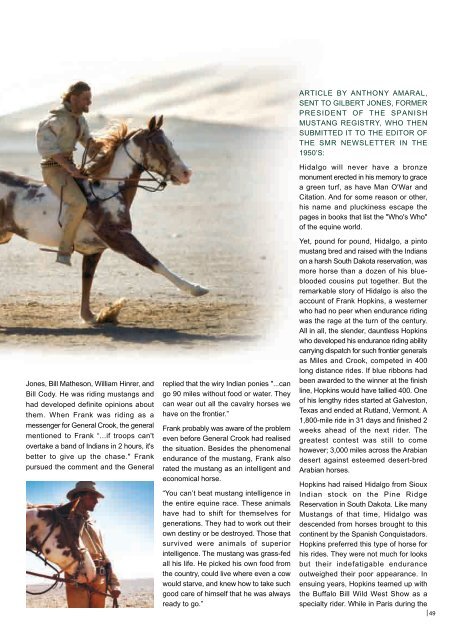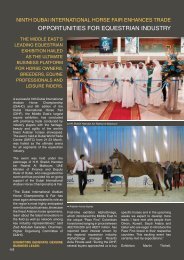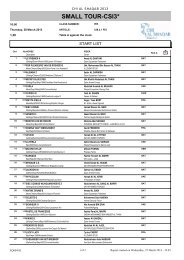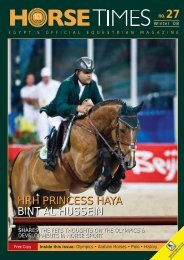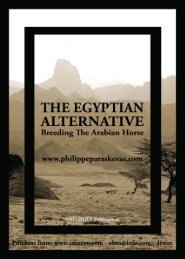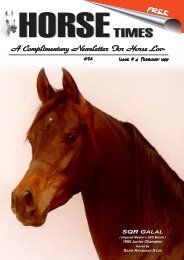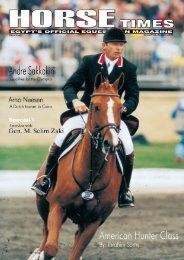HIDALGO & FRANK HOPKINS HORSES IN HISTORY ... - Horse Times
HIDALGO & FRANK HOPKINS HORSES IN HISTORY ... - Horse Times
HIDALGO & FRANK HOPKINS HORSES IN HISTORY ... - Horse Times
Create successful ePaper yourself
Turn your PDF publications into a flip-book with our unique Google optimized e-Paper software.
Jones, Bill Matheson, William Hinrer, and<br />
Bill Cody. He was riding mustangs and<br />
had developed definite opinions about<br />
them. When Frank was riding as a<br />
messenger for General Crook, the general<br />
mentioned to Frank “...if troops can't<br />
overtake a band of Indians in 2 hours, it's<br />
better to give up the chase." Frank<br />
pursued the comment and the General<br />
replied that the wiry Indian ponies "...can<br />
go 90 miles without food or water. They<br />
can wear out all the cavalry horses we<br />
have on the frontier.”<br />
Frank probably was aware of the problem<br />
even before General Crook had realised<br />
the situation. Besides the phenomenal<br />
endurance of the mustang, Frank also<br />
rated the mustang as an intelligent and<br />
economical horse.<br />
“You can’t beat mustang intelligence in<br />
the entire equine race. These animals<br />
have had to shift for themselves for<br />
generations. They had to work out their<br />
own destiny or be destroyed. Those that<br />
survived were animals of superior<br />
intelligence. The mustang was grass-fed<br />
all his life. He picked his own food from<br />
the country, could live where even a cow<br />
would starve, and knew how to take such<br />
good care of himself that he was always<br />
ready to go.”<br />
ARTICLE BY ANTHONY AMARAL,<br />
SENT TO GILBERT JONES, FORMER<br />
PRESIDENT OF THE SPANISH<br />
MUSTANG REGISTRY, WHO THEN<br />
SUBMITTED IT TO THE EDITOR OF<br />
THE SMR NEWSLETTER <strong>IN</strong> THE<br />
1950’S:<br />
Hidalgo will never have a bronze<br />
monument erected in his memory to grace<br />
a green turf, as have Man O'War and<br />
Citation. And for some reason or other,<br />
his name and pluckiness escape the<br />
pages in books that list the "Who's Who"<br />
of the equine world.<br />
Yet, pound for pound, Hidalgo, a pinto<br />
mustang bred and raised with the Indians<br />
on a harsh South Dakota reservation, was<br />
more horse than a dozen of his blueblooded<br />
cousins put together. But the<br />
remarkable story of Hidalgo is also the<br />
account of Frank Hopkins, a westerner<br />
who had no peer when endurance riding<br />
was the rage at the turn of the century.<br />
All in all, the slender, dauntless Hopkins<br />
who developed his endurance riding ability<br />
carrying dispatch for such frontier generals<br />
as Miles and Crook, competed in 400<br />
long distance rides. If blue ribbons had<br />
been awarded to the winner at the finish<br />
line, Hopkins would have tallied 400. One<br />
of his lengthy rides started at Galveston,<br />
Texas and ended at Rutland, Vermont. A<br />
1,800-mile ride in 31 days and finished 2<br />
weeks ahead of the next rider. The<br />
greatest contest was still to come<br />
however; 3,000 miles across the Arabian<br />
desert against esteemed desert-bred<br />
Arabian horses.<br />
Hopkins had raised Hidalgo from Sioux<br />
Indian stock on the Pine Ridge<br />
Reservation in South Dakota. Like many<br />
Mustangs of that time, Hidalgo was<br />
descended from horses brought to this<br />
continent by the Spanish Conquistadors.<br />
Hopkins preferred this type of horse for<br />
his rides. They were not much for looks<br />
but their indefatigable endurance<br />
outweighed their poor appearance. In<br />
ensuing years, Hopkins teamed up with<br />
the Buffalo Bill Wild West Show as a<br />
specialty rider. While in Paris during the<br />
49


